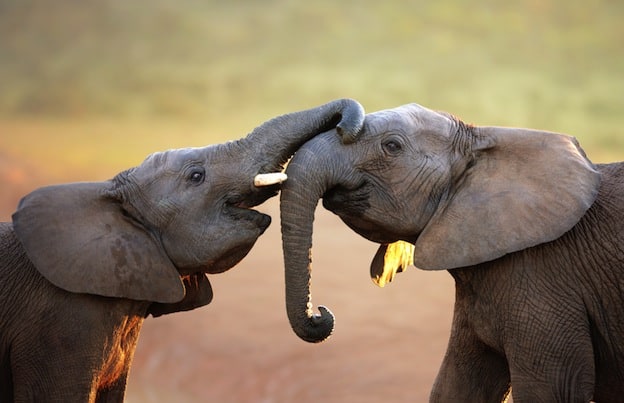
Elephants- Forms of communication
Since elephants are highly intelligent they are among the most fascinating to watch when it comes to how they communicate. They use a combination of both verbal and non verbal methods to convey messages. They are very friendly towards each other for the most part. Watching how they interact and how they communicate while in the wild is an unbelievable experience.
When they choose to execute their verbal forms of communication there is no denying them. They have very loud trumpeting sounds that can be used to signify excitement, aggression, as well as danger. They can send their messages through trumpeting at various frequencies depending on who they wish to contact. It is common for them to generate sounds that can be heard for several miles.
The young learn the call of their mothers from a very early age. She will give a variety of sounds to encourage her young, to scold, and to get them to stay moving along with the rest of the herd. Some people assume that all of the elephants verbal communication is very loud. While it can be, they also use grunts and growls that are extremely low to communicate as well.
When males want to attract females they can offer very high pitched trumpeting sounds for many hours throughout the day. This will continue in order to attract females. It is believed that this can actually put a female into estrus which will make them give off powerful hormones and want to make with the males that are calling out there.
When it come to non verbal communication the elephant has many to offer. When they come into contact with those they know they often wrap their trunks around each other. This is a sign of excitement and affection, similar to how humans give each other a hug or even shake hands. They can also be seen rubbing their bodies against each other as a sign of affection.
 Elephants touching each other gently
Elephants touching each other gently
The mothers are extremely affectionate towards their calves. They are often seen touching them with their trunks just like humans will pat a child on the head. The position of the trunk also is a sign of communication among them. When the trunk is raised it can mean that a male is standing his ground. It can be considered a threat if another male has his raised as well. When the trunks are in a downward position though that is a sign of friendliness.
Due to the high level of intelligence among elephants, they are one of the animals that seem to have a more sophisticated form of communication than others. They fact that they experience emotions that are very similar to those of humans means that they also show comfort through their forms of communication. This is even more so when a baby is dead at birth or an elder member of the herd dies.
While experts do know more about elephant communication than with many other animals, there are still areas that they need to investigate further. One that is puzzling is that when another herd is coming or there is danger there it one elephant that will trumpet the warning about it. How is it decided which one will do this? It isn’t necessarily the dominate elephant and it isn’t always the same one in that role? This is a mystery that many would love to find the answer to.
I really enjoy reading this note. now, I know more about elephnats’ communication.
We’re glad you enjoyed the article, and learned something new about Elephants!
good information
Thank you very much 😀